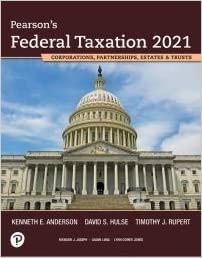One way to compare the accumulation of income by alternative business entity forms is to use mathematical
Question:
One way to compare the accumulation of income by alternative business entity forms is to use mathematical models. The following models express the investment after-tax accumulation calculation for a particular entity form:
Pass-through entities and sole proprietorships: Contribution * [1 + R(1 - 0.8 tp)]n C corporation: Contribution * {[1 + R(1 - tc)]n(1 - tg) + tg}
Where: ATA = after-tax accumulation in n years
R = before-tax rate of return for the business entity
tp = owner’s marginal tax rate on ordinary income
0.8 tp = owner’s marginal tax rate as adjusted to reflect the 20% qualified business income deduction
tc = corporation’s marginal tax rate
tg = owner’s tax rate on capital gains
n = number of periods
In the C corporation model, the corporation operates for n years, paying taxes currently and distributing no dividends. At the end of its existence, the corporation liquidates, causing the shareholder to recognize a capital gain. In the pass-through model, the entity or sole proprietorship distributes just enough cash for the owner or owners to pay individual taxes, and the entity reinvests the remaining after-tax earnings in the business. (See Chapter I:18 of the Individuals volume for a detailed explanation of these models. The Comprehensive volume, however, does not contain Chapter I:18.) Now consider the following facts. Your client has $100,000 to invest in a business. She is trying to decide whether to operate as a proprietorship or as a C corporation. She expects the business to operate for 20 years after which time she will cease business and either liquidate the corporation or take the remaining after-tax accumulation out of the proprietorship. She expects the business to earn a 10% before-tax rate of return regardless of which form she chooses. The corporate tax rate will be 21%, and her tax rate on ordinary income will be 37%. However, she will claim the 20% qualified business deduction on her sole proprietorship earnings if she operates in that form, assuming she qualifies for the full 20% deduction. Her capital gains tax rate will be a combined 23.8%, which includes the 3.8% tax on net investment income. While operating, the corporation will pay no dividends and will reinvest all its after-tax earnings in its business until it liquidates. If your client operates as a sole proprietorship, however, she will withdraw just enough earnings from the business each year to pay her current taxes on the business income. The remaining after-tax earnings will remain in the business until the end of the investment period in 20 years.
Required:
a. Using the models described at the beginning of this problem, determine the after-tax accumulation of each alternative and decide which alternative your client should adopt.
b. How would your answer to Part a change if the investment period is 40 years instead of 20 years?
c. How would your answer to Part a change if your client did not qualify for the qualified business income deduction?
Step by Step Answer:

Federal Taxation 2021 Corporations, Partnerships, Estates & Trusts
ISBN: 9780135919460
34th Edition
Authors: Timothy J. Rupert, Kenneth E. Anderson, David S. Hulse





